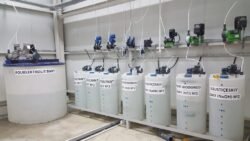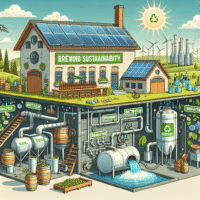Bag Filters For Wastewater Treatment

Bag Filters for Wastewater Treatment: A Comprehensive Overview
Introduction
Water is a vital resource for life and industrial processes. As the demand for water continues to grow, so does the need for effective wastewater treatment solutions. Among the various technologies available, bag filters play a crucial role in the treatment of wastewater. This article delves into the intricacies of bag filters, their mechanisms, advantages, applications, and future potential in wastewater treatment.
The Basics of Bag Filters
Bag filters are a popular choice for industrial and municipal wastewater treatment systems because of their simplicity, efficiency, and flexibility. These filters are essentially bags made of various materials designed to capture and retain debris, particulates, and contaminants from wastewater. The filters are typically housed in a bag filter vessel, where the dirty water enters, and clean water exits.
Types of Bag Filters
Bag filters come in several types, each designed for specific applications and operational needs. The primary types include:
-
- Standard Bag Filters: These are the most commonly used and are suitable for general filtration purposes. They capture particles of varying sizes and are often used in the preliminarily or secondary stages of wastewater treatment.
-
- Pleated Bag Filters: Featuring pleated designs, these filters have a larger surface area compared to standard bags, allowing for a higher dirt-holding capacity and extended service life. They are suitable for applications requiring fine filtration.
-
- High-Capacity Bag Filters: These are designed for heavy-duty applications where a large volume of contaminants needs to be filtered out. They are often used in industries such as chemicals, food and beverage, and pharmaceuticals.
-
- Oil Absorbing Bag Filters: Specially designed to remove oils and hydrocarbons from wastewater, these filters are commonly used in industries like petrochemicals and automotive manufacturing.
Materials Used in Bag Filters
Bag filters can be made from various materials, each offering distinct advantages. The choice of material depends on the specific application and the nature of the contaminants. Common materials include:
-
- Polypropylene: Known for its chemical resistance and cost-effectiveness, polypropylene is a popular choice for bag filters used in diverse applications.
-
- Nylon: Nylon bag filters offer high tensile strength and are suitable for capturing fine particles. They are often used in food and beverage industries.
-
- Polyester: With good chemical resistance and durability, polyester bag filters are ideal for applications involving high-temperature wastewater.
-
- Fiberglass: Fiberglass bag filters are used in applications where high-temperature resistance is required. They are commonly found in power plants and incineration facilities.
Mechanism of Bag Filters
The primary purpose of a bag filter is to separate solids from the liquid phase in wastewater. The process can be broken down into several stages:
-
- Influent Water Enters the Vessel: The untreated wastewater is introduced into the bag filter vessel.
-
- Filtration Process: As the water flows through the filter bag, contaminants are trapped within the bag, allowing clean water to pass through.
-
- Accumulation of Contaminants: Over time, particulate matter accumulates within the filter bag, reducing its efficiency. Once the bag reaches its holding capacity, it needs to be replaced or cleaned.
-
- Effluent Water Exits the Vessel: The treated water, now free from contaminants, exits the bag filter vessel for further treatment or discharge.
Advantages of Bag Filters
Bag filters offer a multitude of benefits in wastewater treatment:
-
- Cost-Effectiveness: They are relatively inexpensive compared to other filtration systems and have lower operational costs.
-
- Ease of Installation and Maintenance: Bag filters are easy to install and replace, reducing downtime and maintenance costs.
-
- Versatility: They are suitable for a wide range of applications, from municipal wastewater treatment to industrial processes.
-
- High Filtration Efficiency: Bag filters can achieve high levels of filtration efficiency, capturing particles as small as a few microns.
-
- Compact Design: Their compact design makes them suitable for facilities with limited space.
Applications of Bag Filters in Wastewater Treatment
Municipal Wastewater Treatment
Municipal wastewater comprises domestic sewage, industrial effluents, and stormwater runoff. Bag filters are used in municipal treatment plants to remove suspended solids, organic matter, and other contaminants, thereby ensuring water quality standards are met before discharge into the environment or reuse.
Industrial Wastewater Treatment
Different industries generate wastewater with unique characteristics. Bag filters are tailored to meet the specific needs of various industries, including:
-
- Food and Beverage: Processes within this industry generate significant amounts of organic waste, oils, and greases. Bag filters help in removing these contaminants, ensuring safe discharge or reuse of water.
-
- Pharmaceuticals: The pharmaceutical industry produces wastewater containing active pharmaceutical ingredients (APIs), solvents, and other chemicals. Bag filters are essential in removing these pollutants, preventing environmental contamination.
-
- Chemicals and Petrochemicals: Industries like chemical manufacturing and petrochemicals use bag filters to remove solids, oils, and hydrocarbons from wastewater, ensuring compliance with stringent environmental regulations.
-
- Metal Finishing and Electroplating: Wastewater from metal finishing processes contains heavy metals, cyanides, and other hazardous substances. Bag filters play a crucial role in capturing these contaminants, ensuring safe disposal.
-
- Automotive: The automotive industry generates wastewater containing oils, greases, and metal particles. Bag filters efficiently remove these contaminants, preventing equipment damage and environmental pollution.
Challenges and Limitations of Bag Filters
While bag filters offer numerous advantages, they are not without challenges:
-
- Bag Replacement and Disposal: Regular replacement of filter bags is required, leading to increased operational costs and waste generation. The disposal of used filters, especially those contaminated with hazardous materials, must be handled responsibly to prevent environmental harm.
-
- Clogging and Pressure Drop: Over time, bag filters can become clogged with accumulated contaminants, leading to a pressure drop and reduced filtration efficiency. This issue necessitates frequent monitoring and maintenance.
-
- Limited Lifespan: Filter bags have a finite lifespan, and their replacement frequency depends on the application and contaminant load. High contaminant loads can lead to shorter filter life.
-
- Mechanical Damage: Bag filters are susceptible to mechanical damage, especially when exposed to sharp or abrasive particles. This can compromise their effectiveness and require frequent replacements.
Innovations and Future Trends in Bag Filtration
The wastewater treatment industry continues to evolve, driven by advancements in technology and increasing regulatory requirements. Innovations in bag filtration aim to address existing challenges and improve efficiency. Some notable trends and developments include:
-
- Advanced Filtration Media: Research and development are focused on creating advanced filtration media with higher durability, chemical resistance, and longer lifespans. Nanofiber technology and composite materials are being explored to enhance filtration performance.
-
- Automation and Monitoring: The integration of automation and monitoring systems in bag filtration units allows real-time performance tracking, predictive maintenance, and remote operation. Smart sensors and IoT-enabled devices provide data-driven insights for optimizing filtration processes.
-
- Hybrid Filtration Systems: Combining bag filters with other filtration technologies, such as membrane filtration or activated carbon adsorption, can enhance overall treatment efficiency. Hybrid systems offer a multi-barrier approach, addressing a wider range of contaminants.
-
- Sustainability Initiatives: The development of biodegradable and environmentally-friendly filter materials aligns with sustainability goals. Efforts to reduce filter waste and promote recycling contribute to a greener future.
Practical Tips for Optimizing Bag Filter Performance
To maximize the efficiency and lifespan of bag filters, consider the following best practices:
-
- Regular Monitoring: Implement a routine monitoring schedule to check for pressure drops, flow rates, and filter condition. Early detection of issues can prevent operational disruptions.
-
- Proper Bag Selection: Choose the appropriate filter bag material and micron rating based on the specific contaminants and application requirements. Consulting with experts can ensure optimal filter performance.
-
- Effective Pre-Treatment: Implementing pre-treatment processes, such as screening or sedimentation, can reduce the contaminant load entering the bag filters, prolonging their lifespan and efficiency.
-
- Scheduled Maintenance: Establish a maintenance schedule for filter bag replacement, cleaning, and vessel inspection. Preventive maintenance minimizes downtime and ensures consistent performance.
-
- Staff Training: Ensure that personnel responsible for operating and maintaining bag filters are adequately trained. Proper handling and knowledge of best practices contribute to effective wastewater management.
Case Studies: Bag Filters in Action
Case Study 1: Municipal Wastewater Treatment Plant
A municipal wastewater treatment plant serving a population of 100,000 implemented bag filters in the pre-treatment stage to remove coarse solids and organics. The filters successfully reduced the contaminant load on subsequent treatment processes, enhancing overall plant efficiency and reducing chemical consumption. The plant reported improved effluent quality and compliance with regulatory standards.
Case Study 2: Chemical Manufacturing Facility
A chemical manufacturing facility faced challenges in treating wastewater containing fine particles and chemical residues. By incorporating pleated bag filters with advanced filtration media, the facility achieved significant improvements in contaminant removal. The extended filter life reduced maintenance costs, and the facility maintained compliance with stringent discharge regulations.
Case Study 3: Food and Beverage Industry
A food processing plant producing large volumes of oily wastewater implemented oil-absorbing bag filters. The filters effectively captured oils and greases, preventing equipment fouling and ensuring safe discharge. The plant reported increased operational efficiency and reduced environmental impact.
Conclusion
Bag filters have emerged as indispensable components in the field of wastewater treatment. Their versatility, cost-effectiveness, and high filtration efficiency make them suitable for a wide range of applications across various industries. While challenges exist, ongoing innovations and best practices continue to enhance the performance and sustainability of bag filtration systems. As technology advances and environmental regulations become more stringent, bag filters will play a pivotal role in ensuring clean and safe water for future generations.


